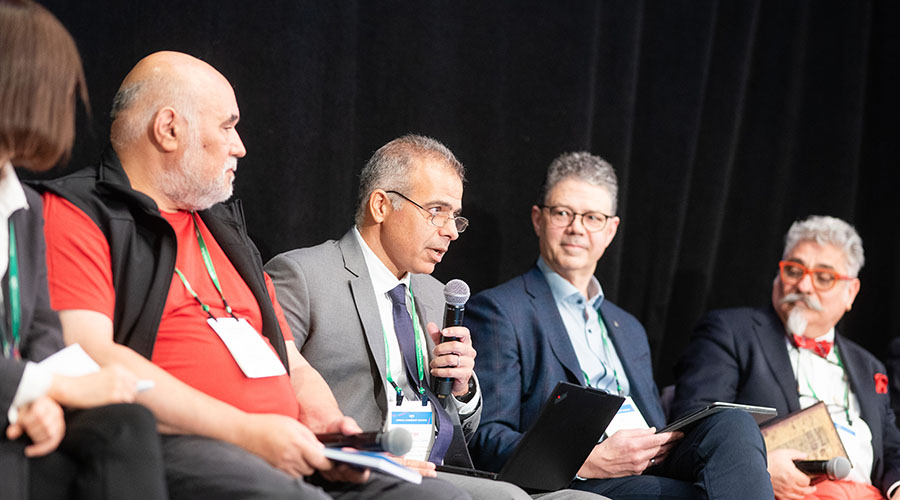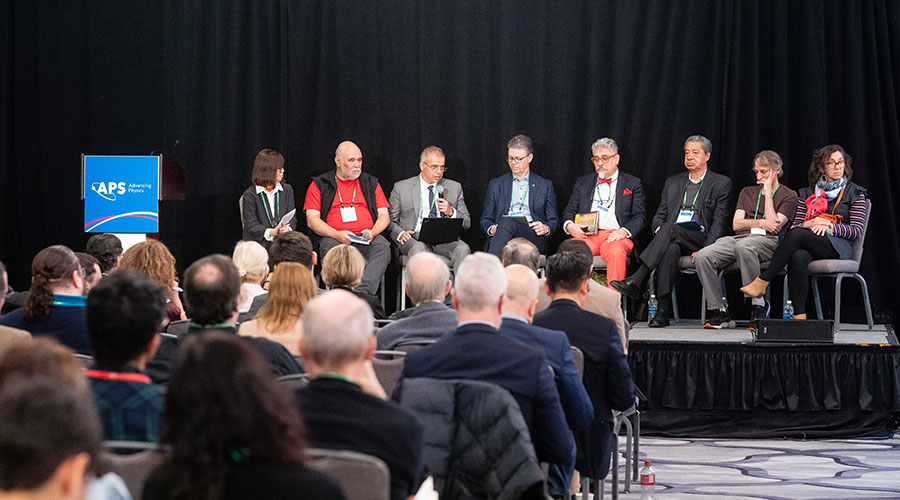At the APS Annual Leadership Meeting, the heads of physics societies throughout the Americas discussed their visions for the future.
By Bailey Bedford | February 16, 2024

Credit: American Physical Society
Rodrigo Barbosa Capaz, president of the Brazilian Physical Society, speaks during an APS panel.
Now more than ever, physics is a global effort. Researchers work with colleagues in distant countries, building on decades of scientific progress made around the world. In recognition of this trend, the theme of APS’s 2024 Annual Leadership Meeting — hosted in Washington, D.C., from Jan. 23 to 26 — was “creating global community connections.”
One panel, “Challenges Facing International Physics Societies,” sat down six leaders of prominent physics societies from across North, Central, and South America, as well as the president designate of the International Union of Pure and Applied Physics (IUPAP). Young-Kee Kim, the 2024 APS president, moderated the panel. Though separated by borders and thousands of miles, these societies have much in common.
“Membership-based organizations like APS — our physics societies — are facing many shared challenges,” said Kim. “And many challenges cannot be solved or resolved by one country.” To make progress, she suggested, physics leaders have to “roll up our sleeves” and sit down together to brainstorm.
And they did. The previous day, the group had participated in a regional summit for leaders of physics societies in the Americas. During the panel, they shared insights from the summit.
“Despite the fact that we are obviously in different stages of development in physics, we share a very large number of challenges — for instance, increasing public awareness in science, improving high school physics curricula, and enhancing gender and racial equity in physics,” said Rodrigo Capaz, president of the Brazilian Physical Society.
Inequitable representation in physics, including by gender and race, was a recurring theme. In the U.S., for example, only about 25% of physics bachelor’s degrees were awarded to women in 2021, and less than 4% were awarded to Black students. Capaz noted that Brazil and the U.S. — both home to many people with African ancestry, as a result of similar historic experiences with the African diaspora — now face similar challenges with racial inequity in physics. And Leopoldo Soto, president of the Chilean Physical Society, added that efforts to promote equity in physics must also include members of the neurodivergent community, such as those who have autism, obsessive-compulsive disorder, or bipolar disorder.
The panel also talked at length about international collaborative efforts, some in progress already. Nathan Berkovits, the director of the ICTP South American Institute for Fundamental Research (ICTP-SAIFR), discussed a project in which his organization translated, into Portuguese and Spanish, high school physics lessons produced by the Perimeter Institute in Canada — an effort supported in part by the APS Innovation Fund.

Credit: American Physical Society
APS President Young-Kee Kim (left) and the seven panelists, all leaders of physics organizations throughout the Americas and beyond.
Julio Mendoza Alvarez, president of the Mexican Physical Society, described future opportunities for international collaboration, like creating a shared catalog of physics programs throughout the Americas and expanding Mexico’s annual science outreach event, The Night of the Stars, to additional countries.
To be successful, partnerships should be mutually advantageous, Capaz noted: “One thing that is very important, especially again when you realize that and understand that perhaps in the Americas we are talking about very asymmetric partnerships between countries at different stages of development, is we need to find a balance in which partnership is beneficial to both sides.”
Some mutually beneficial types of partnership enable the movement of people — for example, ensuring that students can study internationally and researchers can travel abroad for their work. Omar Osenda, president of the Argentina Physical Association, emphasized that Argentina’s physicists and students are a valuable resource in and of themselves.
But managing physical resources can benefit from collaboration, too. For example, Chile, Argentina, and Bolivia have natural sources of lithium, explained Leopoldo Soto, president of the Chilean Physical Society; coordinating the use of lithium is important not only for building batteries but also for its future applications in nuclear energy.
These ambitions rely on the field’s ability to train and retain the next generation of physicists, as well as empower them to solve emerging problems — needs that physics societies could help meet. William Whelan, president of the Canadian Association of Physicists, suggested that expanding the definition of physics to include related fields might attract middle and high school students, by presenting physics as an interdisciplinary approach to addressing global challenges that concern them. Silvina Ponce Dawson, president designate of IUPAP, noted that Societies could offer more support for researchers studying physics with applications for sustainability, as well as create programs that train doctoral physicists to apply their expertise to modeling climate change.
The panelists seemed eager to move forward.
“There are real opportunities here for us to share information, share ideas, exchange ideas,” Whelan said. “We were told yesterday this is the start of the conversation, so I'm excited about that.”
Bailey Bedford is a science journalist based in the Washington, D.C. area.
©1995 - 2024, AMERICAN PHYSICAL SOCIETY
APS encourages the redistribution of the materials included in this newspaper provided that attribution to the source is noted and the materials are not truncated or changed.
Editor: Taryn MacKinney
March 2024 (Volume 33, Number 2)
Articles in this Issue

